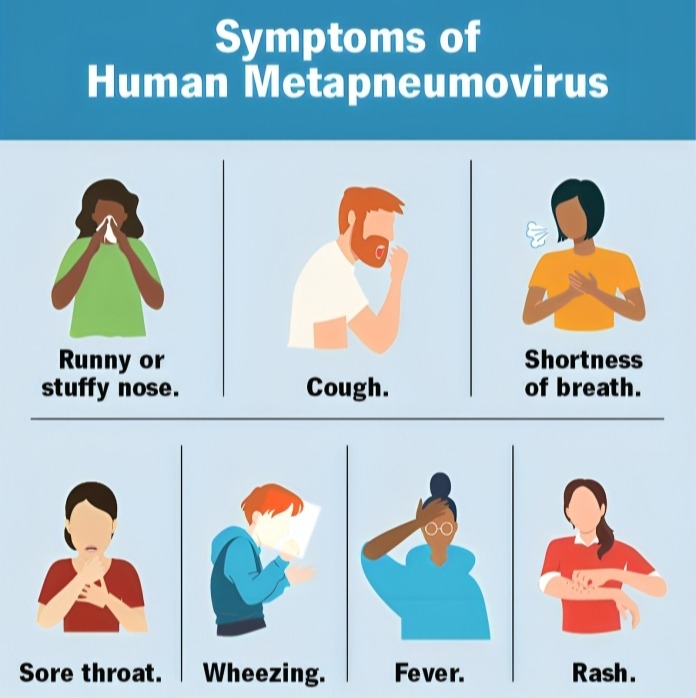Human Metapneumovirus (HMPV): A Global Health Concern
Human Metapneumovirus (HMPV), a respiratory virus first identified in 2001, has emerged as a significant health concern worldwide. The virus, closely related to respiratory syncytial virus (RSV), primarily affects young children, the elderly, and those with compromised immune systems. With increasing global cases, understanding HMPV and adopting preventive measures is crucial.
EXPERT ANALYSIS
GeopoliticsTv Team
1/9/20252 min read


Human Metapneumovirus (HMPV), a respiratory virus first identified in 2001, has emerged as a significant health concern worldwide. The virus, closely related to respiratory syncytial virus (RSV), primarily affects young children, the elderly, and those with compromised immune systems. With increasing global cases, understanding HMPV and adopting preventive measures is crucial. Cases have been reported in countries including China, India, Malaysia, Republic of Kazakhstan. Countries have issued advisories for their citizens.
What Is HMPV?
HMPV belongs to the Pneumoviridae family and causes respiratory infections. While most cases are mild, severe complications such as bronchitis, pneumonia, or acute respiratory distress can occur.
Symptoms of HMPV
The symptoms of HMPV often overlap with other respiratory viruses:
Mild Symptoms: Cough, runny nose, sore throat, and fever.
Severe Symptoms: Shortness of breath, wheezing, chest pain, and high fever.
Severe infections may require hospitalization, particularly in high-risk individuals.
Global Spread and Epidemiology
HMPV is prevalent worldwide, with cases peaking during late winter and early spring in temperate regions. Recent outbreaks in East Asia, particularly China, have highlighted its potential to strain healthcare systems. HMPV is now recognized as one of the leading causes of respiratory hospitalizations, second only to RSV in some studies.
How Is HMPV Transmitted?
HMPV spreads primarily through:
Respiratory Droplets: Sneezing or coughing.
Direct Contact: Touching contaminated surfaces or hands and then touching the face.
Close Contact: Being near an infected individual.
The virus can survive on surfaces for hours, making hand hygiene essential for prevention.
Preventive Measures
Since there is no vaccine or specific antiviral treatment for HMPV, prevention focuses on reducing exposure:
1. Practice Good Hygiene
Wash hands frequently with soap and water for at least 20 seconds.
Use alcohol-based hand sanitizers when soap is unavailable.
2. Avoid Contact with Sick Individuals
Maintain a safe distance from anyone exhibiting respiratory symptoms.
Avoid sharing personal items like towels, utensils, or phones.
3. Disinfect Surfaces
Regularly clean frequently-touched surfaces such as doorknobs, light switches, and phones.
4. Wear Masks in Crowded Areas
Masks can reduce the risk of inhaling respiratory droplets in public spaces.
5. Strengthen Immunity
Maintain a healthy diet, exercise regularly, and get adequate sleep.
Diagnosis and Treatment
Diagnosis: HMPV is confirmed through lab tests such as PCR or antigen-based detection from respiratory samples.
Treatment: Symptom management includes:
Rest and hydration.
Over-the-counter medications for fever and pain relief.
In severe cases, oxygen therapy or mechanical ventilation may be necessary.
High-Risk Groups
HMPV poses a greater risk to:
Children under five years old.
Older adults, particularly those with chronic health conditions.
Immunocompromised individuals, such as cancer or transplant patients.
Global Health Response
Public health organizations like the WHO and CDC are monitoring HMPV trends and promoting awareness. Continued research is focused on vaccine development and antiviral therapies to combat the virus.
Key Takeaways
Human Metapneumovirus is a global respiratory threat that demands vigilance. By adopting preventive measures, maintaining good hygiene, and recognizing symptoms early, individuals can significantly reduce the risk of infection. Global collaboration and awareness are essential to mitigate its impact on public health.
